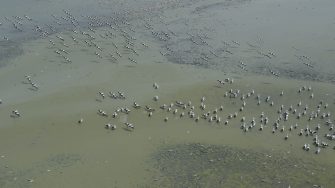
Date: Friday, November 1, 2019
Project: Eastern Australian Waterbird Survey
Observers: Richard Kingsford & Paul Wainright
Pilot: Tim Dugan
Up early again and we headed northeast out of Goolwa for the South Australian riverlands, along the River Murray. Between the Lower Lakes and the riverlands, the river is pretty much confined to a single channel as it snakes its ways south.
We started our second count of all the wetlands between Lock 3, near Banrock Station in the south, and Lock 10 at Wentworth in the northeast in the morning - the same track we followed a couple of days before. The river between the different locks is a good way of breaking up the River Murray into the sections for counting waterbirds.
So we knew what to expect in terms of waterbirds, given we had been there a couple of days earlier. The large permanently filled lakes, alongside the river along here are really only productive for the fish-eating birds, the cormorants and the pelicans. They made up about three quarters of the waterbirds along here today.
The highest concentration of waterbirds in our morning survey, perhaps a few thousand waterbirds, was on a salt lake, mainly with grey teal, pink-eared duck, avocets and pied stilts.
In some parts, the River Murray is really spectacular, with its red and white cliffs dropping straight onto the water.
Most of the time we surveyed along the River Murray but we also made detours for any lakes on the floodplain; most were dry this year. The floodplain seldom if ever floods down here anymore because the river doesn’t get high enough. Many of these floodplains are now baked white with salt, which isn’t flushed away by the floods that used to come. We also made short detours to the billabongs along the river. There were a few more of these dry this year, compared to previous years. They tend to have a few more waterbirds because they are shallow and the water is still.
We reached Mildura by nine o’clock and had a quick bite to eat, before heading east along a bit more of the Murray, before surveying the Murrumbidgee. The wind was now blowing ferociously, pushing the plane around as we surveyed. After doing the lakes around Robinvale on the River Murray which are permanently full and, like many of these lakes just serve as habitat mostly for fish-eating waterbirds, we headed across to the Murrumbidgee River and its wetlands. Dust was blowing across the horizon, some of it whipped up from dry lakes. This is another service that river flows, including environmental flows, help with because the vegetation binds the soil on the floodplains and other wetlands.
Most of the lakes and floodplains around what is known as the Lowbidgee were dry. Paika Lake, north of Balranald, still had water from environmental flows and was still holding up reasonably well at about seventy percent full, providing a bit of habitat in this dusty and dry environment for some waterbirds.
Piggery Lake is one of the important wetlands in on the Murrumbidgee floodplain, in among the river red gum forests, but it was no more than a puddle, with just a handful of egrets and teal.
The wind had really got up by this stage and it was hard flying with a tail wind, particularly when the plane was flying into the wind and had to follow a lake edge around with the wind behind. The permanently full Tala Lake had its usual complement of a few fish-eating waterbirds and some black duck and grey teal, perhaps only about fifty waterbirds in total. Then it was on to the drying Yanga Lake in Yanga National Park. Here there were hundreds of pelicans feeding on thousands of dead and perhaps dying fish; they seemed to mostly be carp.
We then flew across the massive and very dry Lowbidgee floodplain which is the subject of an ambitious restoration program. There was very little water anywhere, only in a few small waterholes and creek lines and as a result not many waterbirds.
We then headed east, surveying the main part of the Murrumbidgee River but also going out to survey a few of the large river storages on either side of the river. In a wet year, we also survey the rice growing areas. Today, just about everything was dry, although some of the off-river storages had water. For some, there were considerable earthworks underway.
We then surveyed the Ramsar-listed Fivebough Swamp, a wetland of international importance. Most of it was dry, with just a bit of a puddle and a few hundred birds in the middle, not the thousands of waterbirds you can find here in some wet years.
After finishing here, there wasn’t that much more to survey. We picked up the odd farm dam, some of them dry, until we reached Temora which was where we surveyed last week. Next week, we are heading north to the Gwydir, Macquarie Marshes, Narran Lakes and Currawinya Lakes. I am not expecting much in the way of water or waterbirds, despite the prospect of some rain this weekend.
